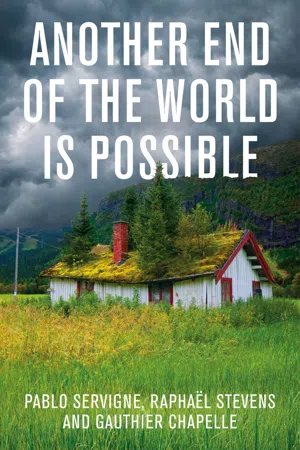
Another End of the World is Possible
Living the Collapse (and Not Merely Surviving It)
- English
- ePUB (mobile friendly)
- Available on iOS & Android
Another End of the World is Possible
Living the Collapse (and Not Merely Surviving It)
About this book
The critical situation in which our planet finds itself is no longer in doubt. Some things are already collapsing while others are beginning to do so, increasing the possibility of a global catastrophe that would mean the end of the world as we know it.
As individuals, we are faced with a daily deluge of bad news about the worsening situation, preparing ourselves to live with years of deep uncertainty about the future of the planet and the species that inhabit it, including our own. How can we cope? How can we project ourselves beyond the present, think bigger and find ways not just to survive the collapse but to live it?
In this book, the sequel to How Everything Can Collapse, the authors show that a change of course necessarily requires an inner journey and a radical rethinking of our vision of the world. Together these might enable us to remain standing during the coming storm, to develop a new awareness of ourselves and of the world and to imagine new ways of living in it. Perhaps then it will be possible to regenerate life from the ruins, creating new alliances in differing directions – with ourselves and our inner nature, between humans, with other living beings and with the earth on which we dwell.
Frequently asked questions
- Essential is ideal for learners and professionals who enjoy exploring a wide range of subjects. Access the Essential Library with 800,000+ trusted titles and best-sellers across business, personal growth, and the humanities. Includes unlimited reading time and Standard Read Aloud voice.
- Complete: Perfect for advanced learners and researchers needing full, unrestricted access. Unlock 1.4M+ books across hundreds of subjects, including academic and specialized titles. The Complete Plan also includes advanced features like Premium Read Aloud and Research Assistant.
Please note we cannot support devices running on iOS 13 and Android 7 or earlier. Learn more about using the app.
Information
Part One
Recovery
What man can feel himself at one and the same time responsible and hopeless?Antoine de Saint-Exupéry, Flight to Arras, trans. L. Galantière
(San Diego, CA: Harcourt Brace & Co, 1986)
1
Experiencing the impact
Living through the disasters
A global increase in the level of mental trauma
Table of contents
- Cover
- Title Page
- Copyright
- Dedication
- Epigraph
- Acknowledgements
- Foreword
- Preface
- Introduction: Learning to live with it
- Part One: Recovery
- Part Two: New Horizons
- Part Three: Collapsosophy
- Conclusion: Apocalypse or ‘happy collapse’?
- Afterword
- End User License Agreement